An Optimal Design Method for Lightweight Heating Film of Anisotropic Heat Conduction Substrate Based on Surrogate Model
Abstract
:1. Introduction
2. Research Object
3. Research Contents
3.1. PSO-BP Surrogate Model
- 1.
- Initialize neural network: Define the structure of the neural network and initialize the weights and thresholds. Initialize the positions and velocities of the particle swarm.
- 2.
- Fitness calculation: Compute the fitness value of each particle using the BP neural network.
- 3.
- Identify best solutions: Identify the personal best (pBest) for each particle and the global best (gBest) among all particles based on their fitness values.
- 4.
- Update velocity and position: Update the velocity and position of each particle based on the pBest, gBest, current position, and velocity.
- 5.
- Iterative optimization: Repeat steps 2–4, iterating until the maximum number of iterations is reached, fitness values stabilize, or other stopping criteria are met.
- 6.
- Assign optimal weights and thresholds: Assign the weights and thresholds from the global best solution found by the PSO algorithm to the BP neural network.
- 7.
- Train BP neural network: Train the BP neural network through forward propagation and error backpropagation until maximum iterations are reached, the error falls below a threshold, or other stopping criteria are met.
- 8.
- Output final model: Output the trained neural network as the final model.

3.2. Multi-Objective Optimization Algorithm
- 1.
- Define objective functions and constraints: Define the optimization objectives and constraints of the problem, which limit the range of feasible solutions.
- 2.
- Initialize population: Generate an initial population of solutions randomly to serve as the starting point for the algorithm.
- 3.
- Evaluate fitness: Use the PSO-BP surrogate model to calculate the fitness of each solution in the initial population.
- 4.
- Select parents: Use non-dominated sorting and crowding distance to select the better solutions as parents for the next generation.
- 5.
- Crossover and mutation: Apply crossover and mutation operations to the parent solutions to produce offspring. Crossover simulates genetic recombination, while mutation introduces genetic variations.
- 6.
- Non-dominated sorting and crowding distance calculation: Perform non-dominated sorting to determine the positions of new solutions on the Pareto front and calculate crowding distances to evaluate solution diversity.
- 7.
- Iterative optimization: Repeat steps 4–6 to iteratively optimize the solution set until the stopping criteria are met, such as reaching the maximum number of generations or achieving a stable fitness value.
- 8.
- Output Pareto optimal front set: Output the Pareto optimal front set of solutions obtained through the optimization process.
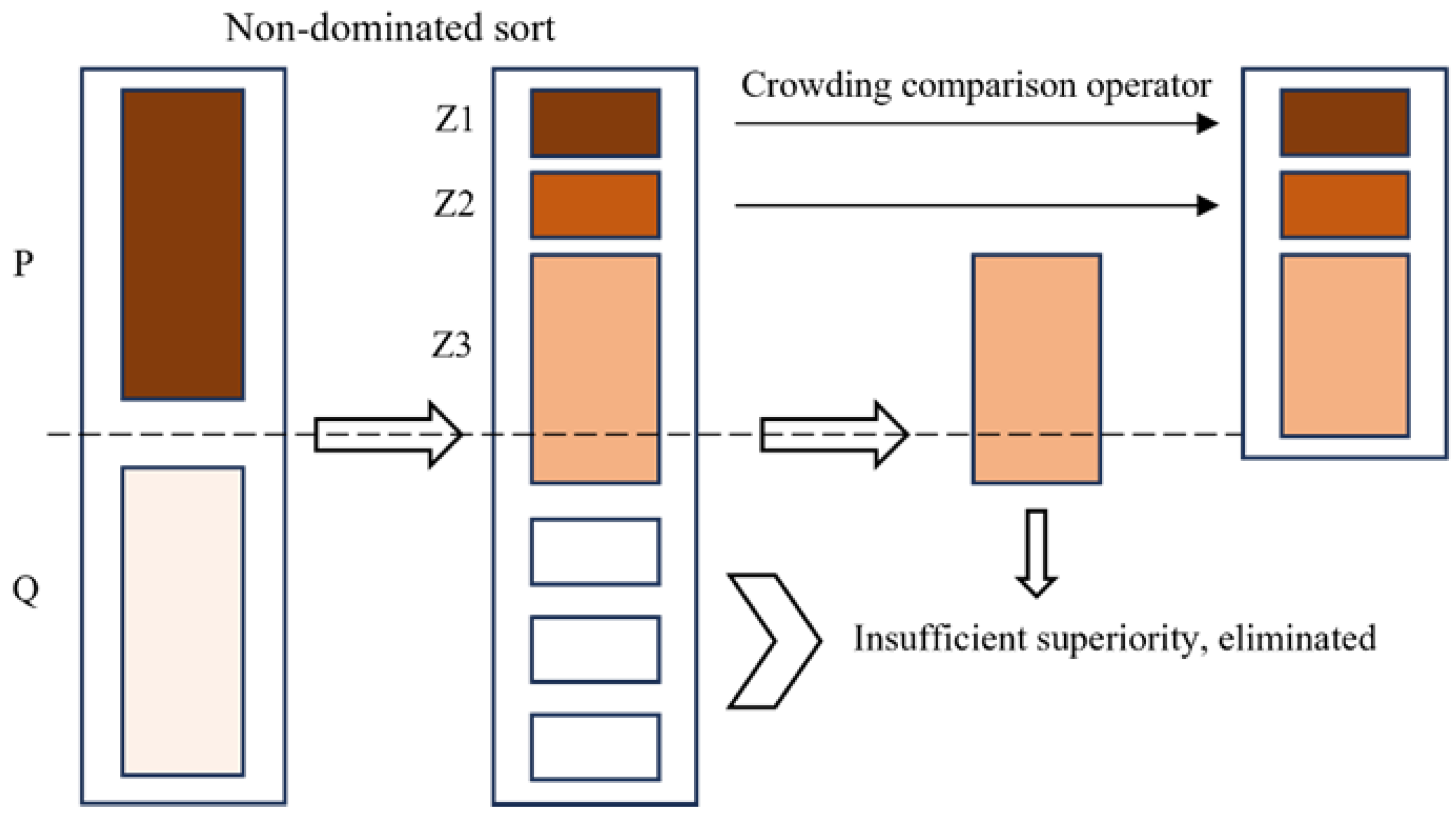
4. Experimental Content
4.1. Training Data Acquisition
4.2. Training Method
4.3. Model Performance Evaluation
4.4. Optimization Design Method
5. Results and Discussion
6. Conclusions
Author Contributions
Funding
Data Availability Statement
Conflicts of Interest
References
- Zhu, Z.; Lu, H.; Zhao, W.; Chang, X. Materials, performances and applications of electric heating films. Renew. Sustain. Energy Rev. 2023, 184, 113540. [Google Scholar] [CrossRef]
- Tachikawa, S.; Nagano, H.; Ohnishi, A.; Nagasaka, Y. Advanced passive thermal control materials and devices for spacecraft: A review. Int. J. Thermophys. 2022, 43, 91. [Google Scholar] [CrossRef]
- Hołyńska, M.; Tighe, A.; Semprimoschnig, C. Coatings and thin films for spacecraft thermo-optical and related functional applications. Adv. Mater. Interfaces 2018, 5, 1701644. [Google Scholar] [CrossRef]
- Zhang, H.; Li, G.; Chen, L.; Man, G.; Miao, J.; Ren, X.; He, J.; Hu, Y. Development of flat-plate loop heat pipes for spacecraft thermal control. Microgravity Sci. Technol. 2019, 31, 435–443. [Google Scholar] [CrossRef]
- Pozo, B.; Machón, L.; Cantero, D.; Muñoz, I. Smart heaters based on flexible electronics for future spacecrafts. In IOP Conference Series: Materials Science and Engineering; IOP Publishing: Bristol, UK, 2023; Volume 1287, p. 012016. [Google Scholar]
- Kyaw, Y.K.; Pronina, P.F.; Polyakov, P.O. Mathematical modelling of the effect of heat fluxes from external sources on the surface of spacecraft. J. Appl. Eng. Sci. 2020, 18, 732–736. [Google Scholar]
- Fu, X.; Liang, L.; Ma, W.; Cui, H.; Zhao, Y. Efficient uncertainty analysis of external heat flux of solar radiation with external heat flux expansion for spacecraft thermal design. Aerospace 2023, 10, 672. [Google Scholar] [CrossRef]
- Wang, Z.; Yu, Y. Study on quick detection method of external heat flux simulator for spacecraft. In IOP Conference Series: Materials Science and Engineering; IOP Publishing: Bristol, UK, 2018; Volume 397, p. 012127. [Google Scholar]
- Engelhart, D.P.; Plis, E.A.; Ferguson, D.; Johnston, W.R.; Cooper, R.; Hoffmann, R.C. Space plasma interactions with spacecraft materials. In Plasma Science and Technology-Basic Fundamentals and Modern Applications; IntechOpen: London, UK, 2019; pp. 225–245. [Google Scholar]
- Gayner, C.; Kar, K.K. Recent advances in thermoelectric materials. Prog. Mater. Sci. 2016, 83, 330–382. [Google Scholar] [CrossRef]
- Im, K.; Cho, K.; Kwak, K.; Kim, J.; Kim, S. Flexible transparent heaters with heating films made of indium tin oxide nanoparticles. J. Nanosci. Nanotechnol. 2013, 13, 3519–3521. [Google Scholar] [CrossRef]
- Gueye, M.N.; Carella, A.; Demadrille, R.; Simonato, J.P. All-polymeric flexible transparent heaters. ACS Appl. Mater. Interfaces 2017, 9, 27250–27256. [Google Scholar] [CrossRef]
- Zhao, Z.; Nan, J.; Li, M. Thermal management of serpentine flexible heater based on the orthotropic heat conduction model. Micromachines 2022, 13, 622. [Google Scholar] [CrossRef]
- Saleem, A.; Zhang, Y.; Gong, H.; Majeed, M.K. Fluoride doped SiC/Si3N4 composite as a high thermal conductive material with enhanced mechanical properties. Ceram. Int. 2019, 45, 21004–21010. [Google Scholar] [CrossRef]
- Zhou, S.; Xu, T.; Jiang, F.; Song, N.; Shi, L.; Ding, P. High thermal conductivity property of polyamide-imide/boron nitride composite films by doping boron nitride quantum dots. J. Mater. Chem. C 2019, 7, 13896–13903. [Google Scholar] [CrossRef]
- Lee, S.M.; Oh, S.; Chang, S.T. Highly Transparent, Flexible Conductors and Heaters Based on Metal Nanomesh Structures Manufactured Using an All-Water-Based Solution Process. Acs Appl. Mater. Interfaces 2019, 11, 4541–4550. [Google Scholar] [CrossRef]
- Han, D.; Li, Y.; Jiang, X.; Zhao, W.; Wang, F.; Lan, W.; Xie, E.; Han, W. A facile method to prepare transparent and stretchable epidermal thin film heaters. Compos. Sci. Technol. 2018, 168, 460–466. [Google Scholar] [CrossRef]
- Sacha, G.M.; Varona, P. Artificial intelligence in nanotechnology. Nanotechnology 2013, 24, 452002. [Google Scholar] [CrossRef]
- Xu, Y.; Zhang, X.; Fu, Y.; Liu, Y. Interfacing photonics with artificial intelligence: An innovative design strategy for photonic structures and devices based on artificial neural networks. Photonics Res. 2021, 9, B135–B152. [Google Scholar] [CrossRef]
- Tezsezen, E.; Yigci, D.; Ahmadpour, A.; Tasoglu, S. AI-Based Metamaterial Design. ACS Appl. Mater. Interfaces 2024, 16, 29547–29569. [Google Scholar] [CrossRef]
- Nan, J.; Chen, J.; Li, M.; Li, Y.; Ma, Y.; Fan, X. A Temperature Prediction Model for Flexible Electronic Devices Based on GA-BP Neural Network and Experimental Verification. Micromachines 2024, 15, 430. [Google Scholar] [CrossRef]
- Xiong, Y.; Guo, L.; Zhang, Y.; Xu, M.; Tian, D.; Li, M. Surrogate modeling for spacecraft thermophysical models using deep learning. Neural Comput. Appl. 2022, 34, 16577–16603. [Google Scholar] [CrossRef]
- Negm, A.; Bakr, M.H.; Howlader, M.M.; Ali, S.M. Deep Learning-Based Metasurface Design for Smart Cooling of Spacecraft. Nanomaterials 2023, 13, 3073. [Google Scholar] [CrossRef]
- He, R.; Schierning, G.; Nielsch, K. Thermoelectric devices: A review of devices, architectures, and contact optimization. Adv. Mater. Technol. 2018, 3, 1700256. [Google Scholar] [CrossRef]
- Zhu, L.; Li, N.; Childs, P.R.N. Light-weighting in aerospace component and system design. Propuls. Power Res. 2018, 7, 103–119. [Google Scholar] [CrossRef]
- Guo, W.; Qiao, Y.; Hou, H. BP neural network optimized with PSO algorithm and its application in forecasting. In Proceedings of the 2006 IEEE International Conference on Information Acquisition, Veihai, China, 20–23 August 2006; IEEE: Piscataway, NJ, USA, 2006; pp. 617–621. [Google Scholar]
- Huang, Y.; Xiang, Y.; Zhao, R.; Cheng, Z. Air quality prediction using improved PSO-BP neural network. IEEE Access 2020, 8, 99346–99353. [Google Scholar] [CrossRef]
- Marini, F.; Walczak, B. Particle swarm optimization (PSO): A tutorial. Chemom. Intell. Lab. Syst. 2015, 149, 153–165. [Google Scholar] [CrossRef]
- Jain, M.; Saihjpal, V.; Singh, N.; Singh, S.B. An overview of variants and advancements of PSO algorithm. Appl. Sci. 2022, 12, 8392. [Google Scholar] [CrossRef]
- Jin, W.; Li, Z.J.; Wei, L.S.; Zhen, H. The improvements of BP neural network learning algorithm. In Proceedings of the WCC 2000—ICSP 2000. 2000 5th International Conference on Signal Processing Proceedings. 16th World Computer Congress 2000, Beijing, China, 21–25 August 2000; IEEE: Piscataway, NJ, USA, 2000; Volume 3, pp. 1647–1649. [Google Scholar]
- Li, J.; Cheng, J.H.; Shi, J.Y.; Huang, F. Brief introduction of back propagation (BP) neural network algorithm and its improvement. In Advances in Computer Science and Information Engineering; Springer: Berlin/Heidelberg, Germany, 2012; Volume 2, pp. 553–558. [Google Scholar]
- Gunantara, N. A review of multi-objective optimization: Methods and its applications. Cogent Eng. 2018, 5, 1502242. [Google Scholar] [CrossRef]
- Konak, A.; Coit, D.W.; Smith, A.E. Multi-objective optimization using genetic algorithms: A tutorial. Reliab. Eng. Syst. Saf. 2006, 91, 992–1007. [Google Scholar] [CrossRef]
- Srinivas, N.; Deb, K. Muiltiobjective optimization using nondominated sorting in genetic algorithms. Evol. Comput. 1994, 2, 221–248. [Google Scholar] [CrossRef]
- Verma, S.; Pant, M.; Snasel, V. A comprehensive review on NSGA-II for multi-objective combinatorial optimization problems. IEEE Access 2021, 9, 57757–57791. [Google Scholar] [CrossRef]
- Deb, K.; Agrawal, S.; Pratap, A.; Meyarivan, T. A fast elitist non-dominated sorting genetic algorithm for multi-objective optimization: NSGA-II. In Proceedings of the Parallel Problem Solving from Nature PPSN VI: 6th International Conference, Paris, France, 18–20 September 2000; Proceedings 6. Springer: Berlin/Heidelberg, Germany, 2000; pp. 849–858. [Google Scholar]
- Kumar, A.A. A comparison of the MOGA and NSGA-II optimization techniques to reduce the cost of a biomass supply network. Mater. Today Proc. 2022, 57, 1553–1558. [Google Scholar]
- Tan, Y.; Zhu, G.; Tian, F.; Zhao, Z.; Chai, B. Multi-objective optimization of T-shaped bilateral laser welding parameters based on NSGA-II and MOPSO. J. Mater. Sci. 2024, 59, 9547–9573. [Google Scholar] [CrossRef]
- Shoaee, M.; Samouei, P. Clusters of floor locations-allocation of stores to cross-docking warehouse considering satisfaction and space using MOGWO and NSGA-II algorithms. Flex. Serv. Manuf. J. 2024, 36, 315–342. [Google Scholar] [CrossRef]
- Hong, H.; Jung, Y.H.; Lee, J.S.; Jeong, C.; Kim, J.U.; Lee, S.; Ryu, H.; Kim, H.; Ma, Z.; Kim, T.-I. Anisotropic Thermal Conductive Composite by the Guided Assembly of Boron Nitride Nanosheets for Flexible and Stretchable Electronics. Adv. Funct. Mater. 2019, 29, 1902575. [Google Scholar] [CrossRef]
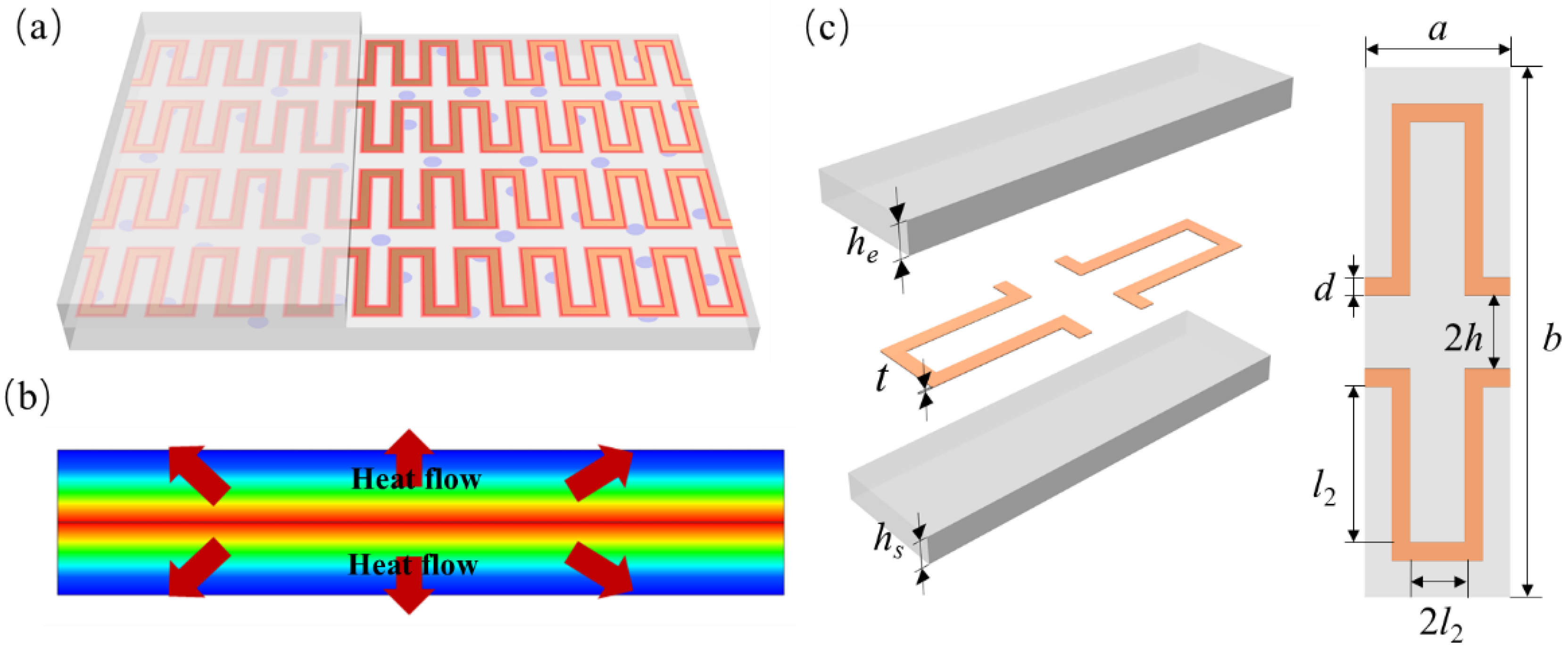
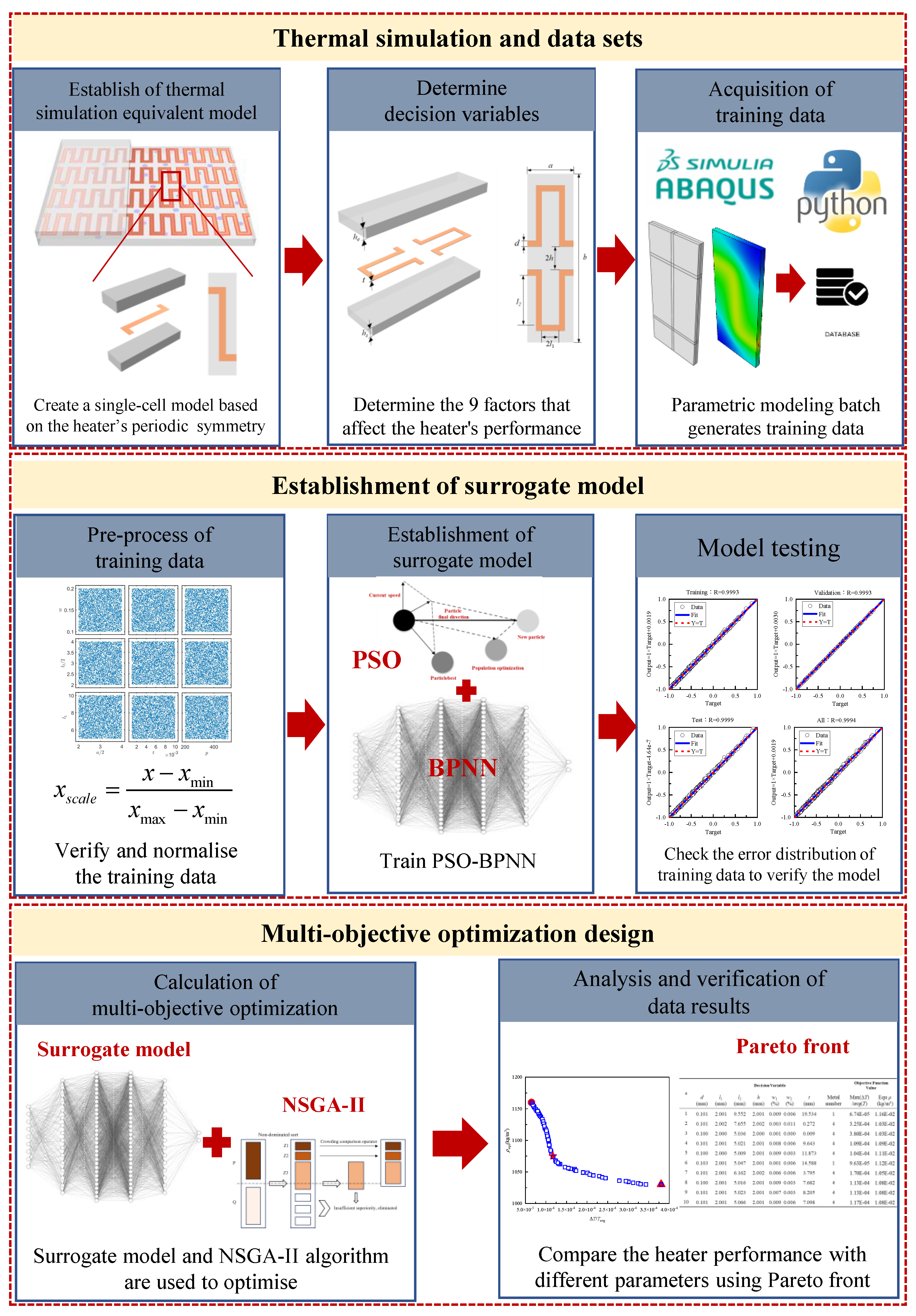
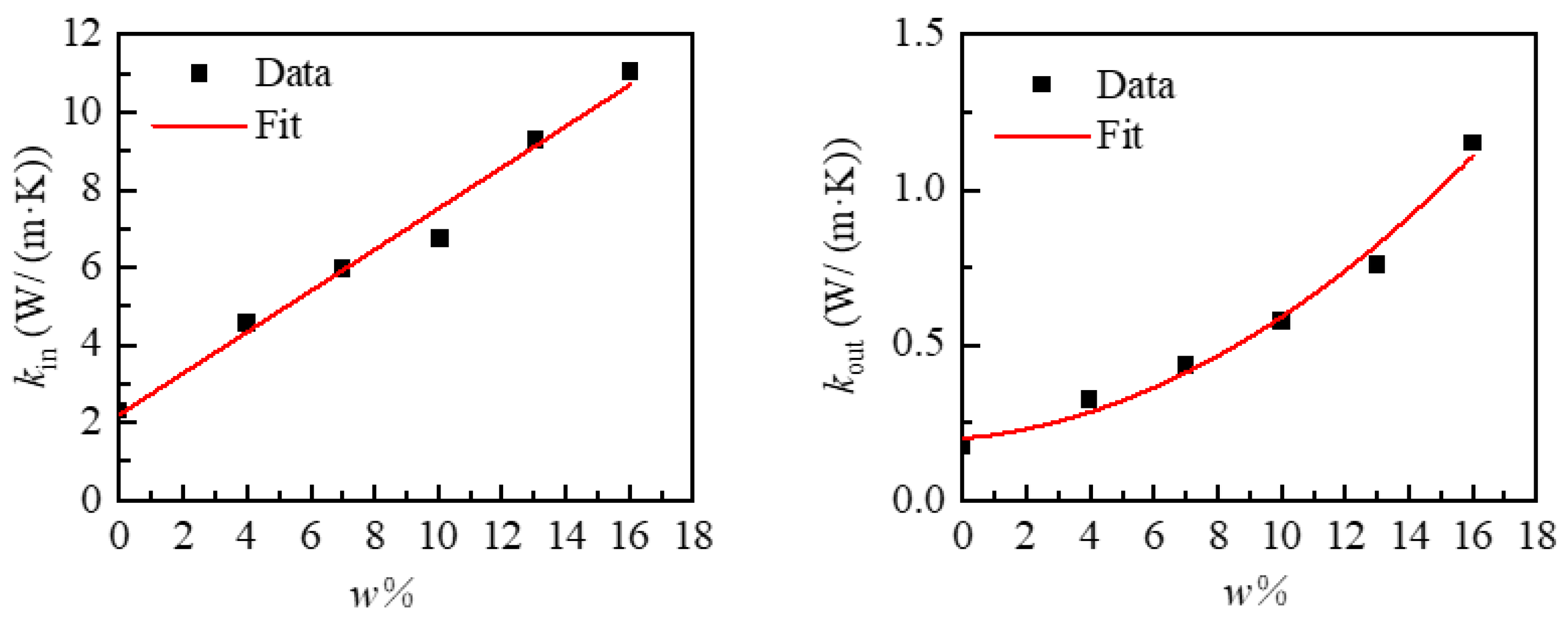

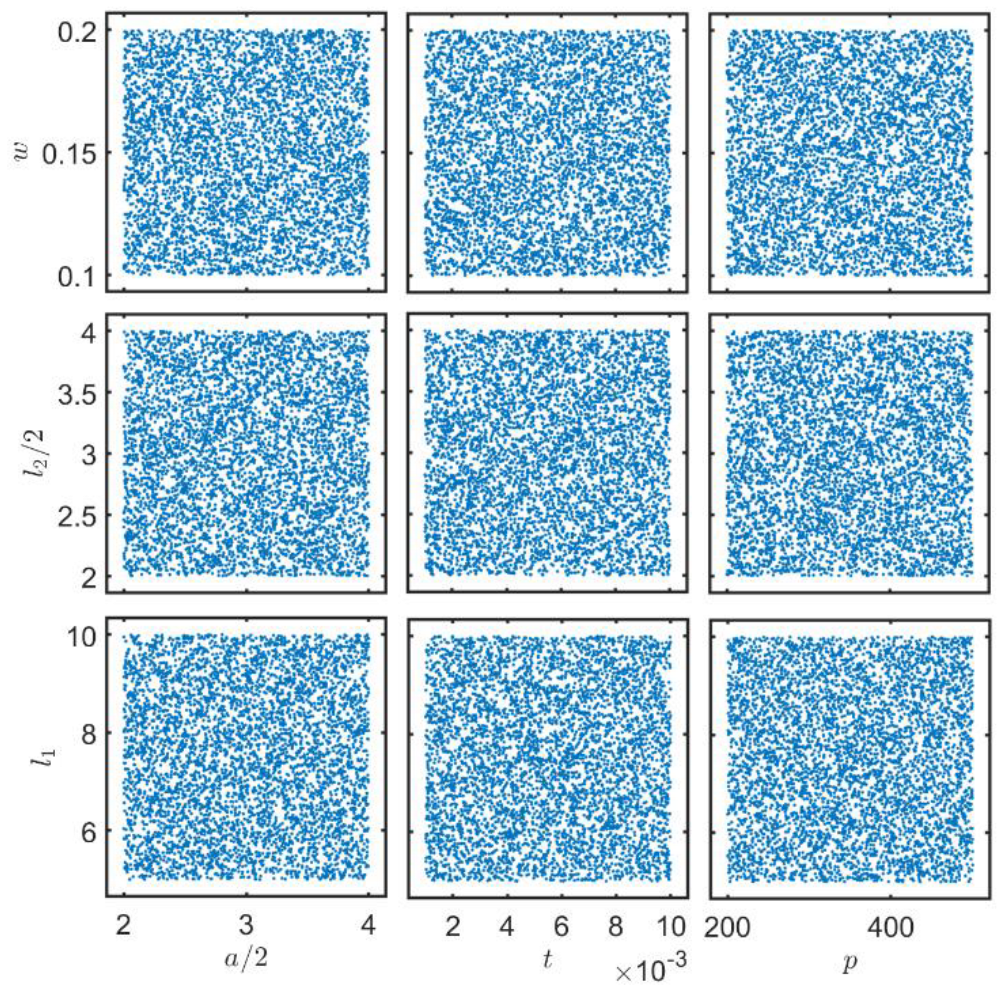
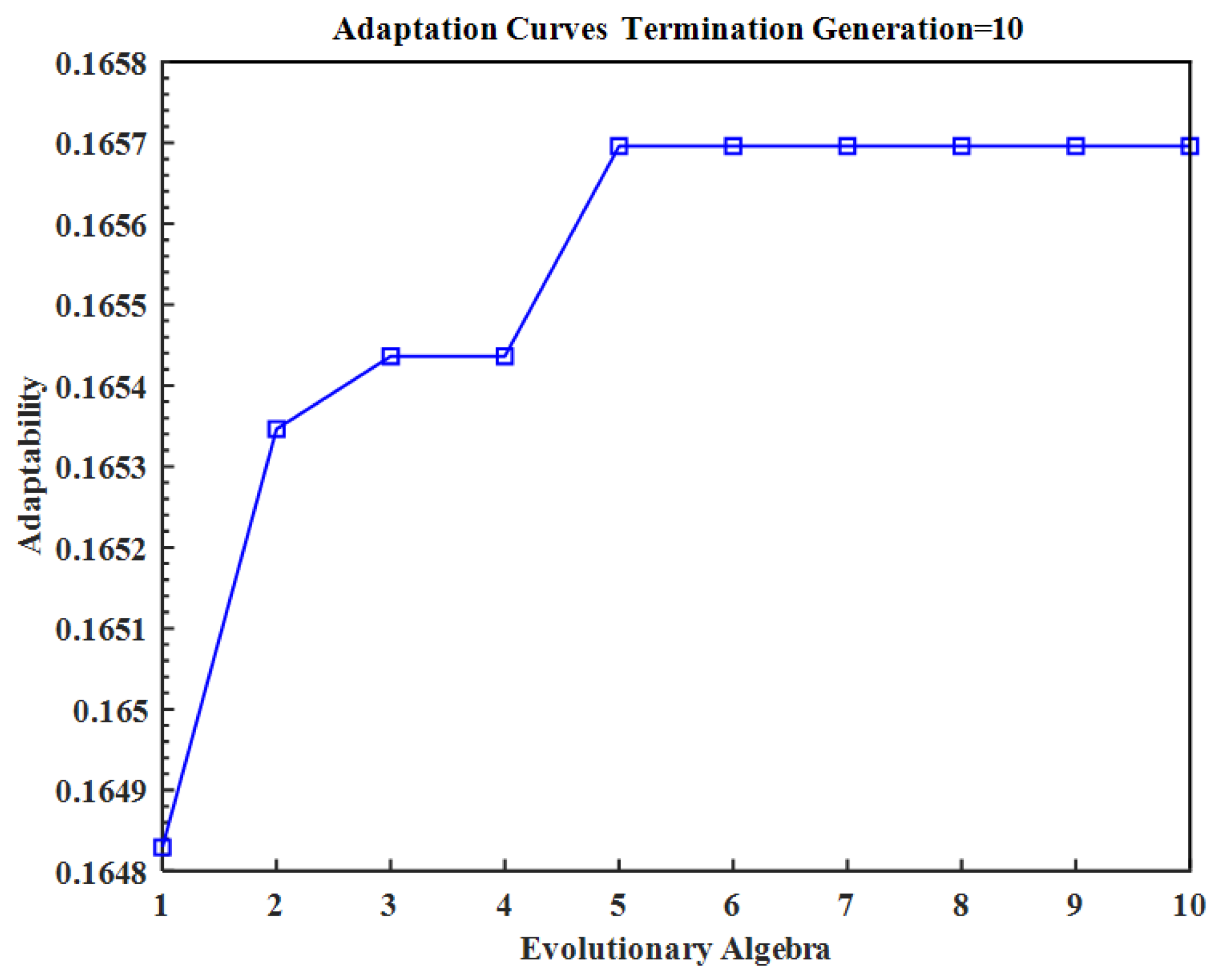
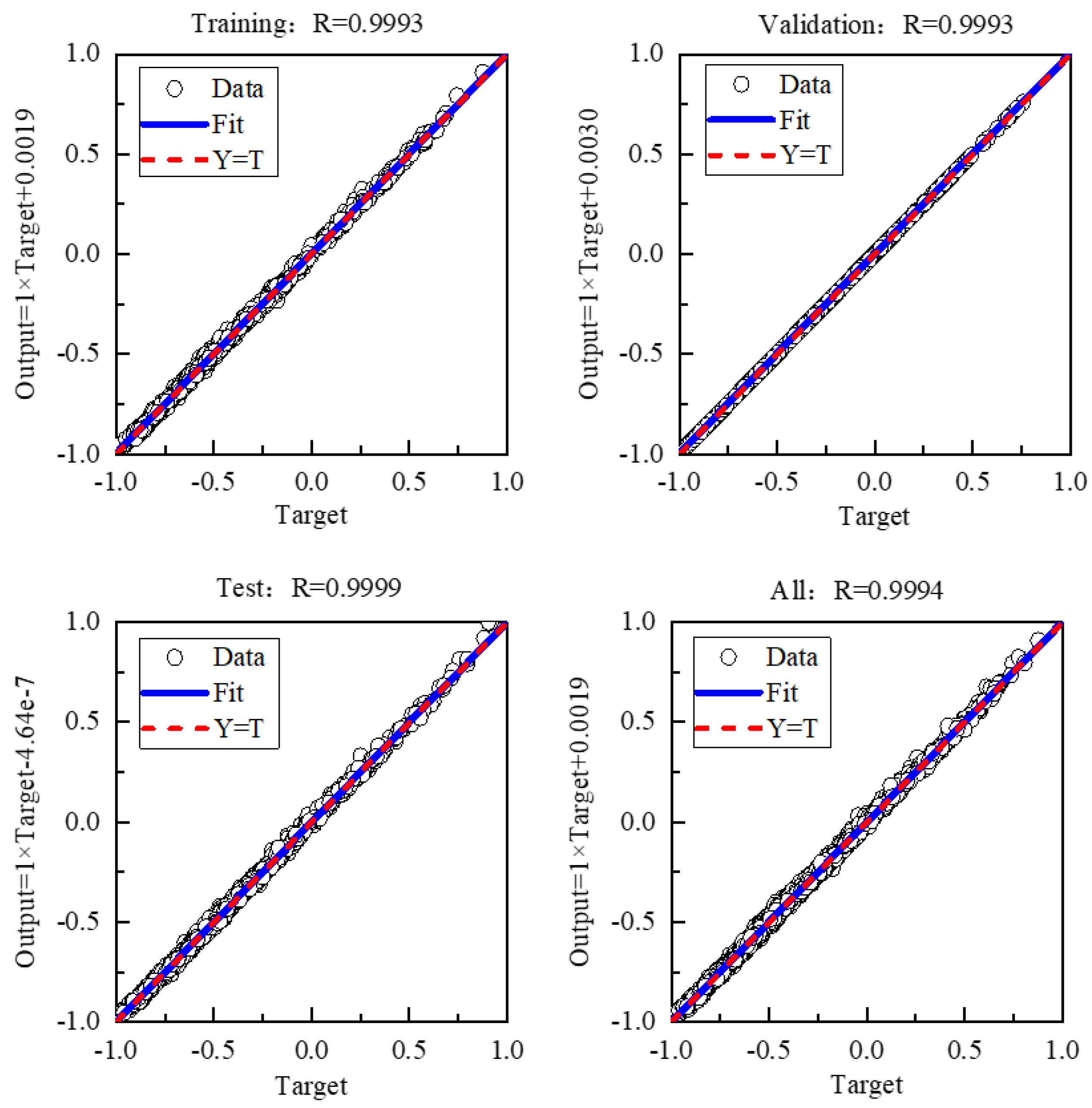

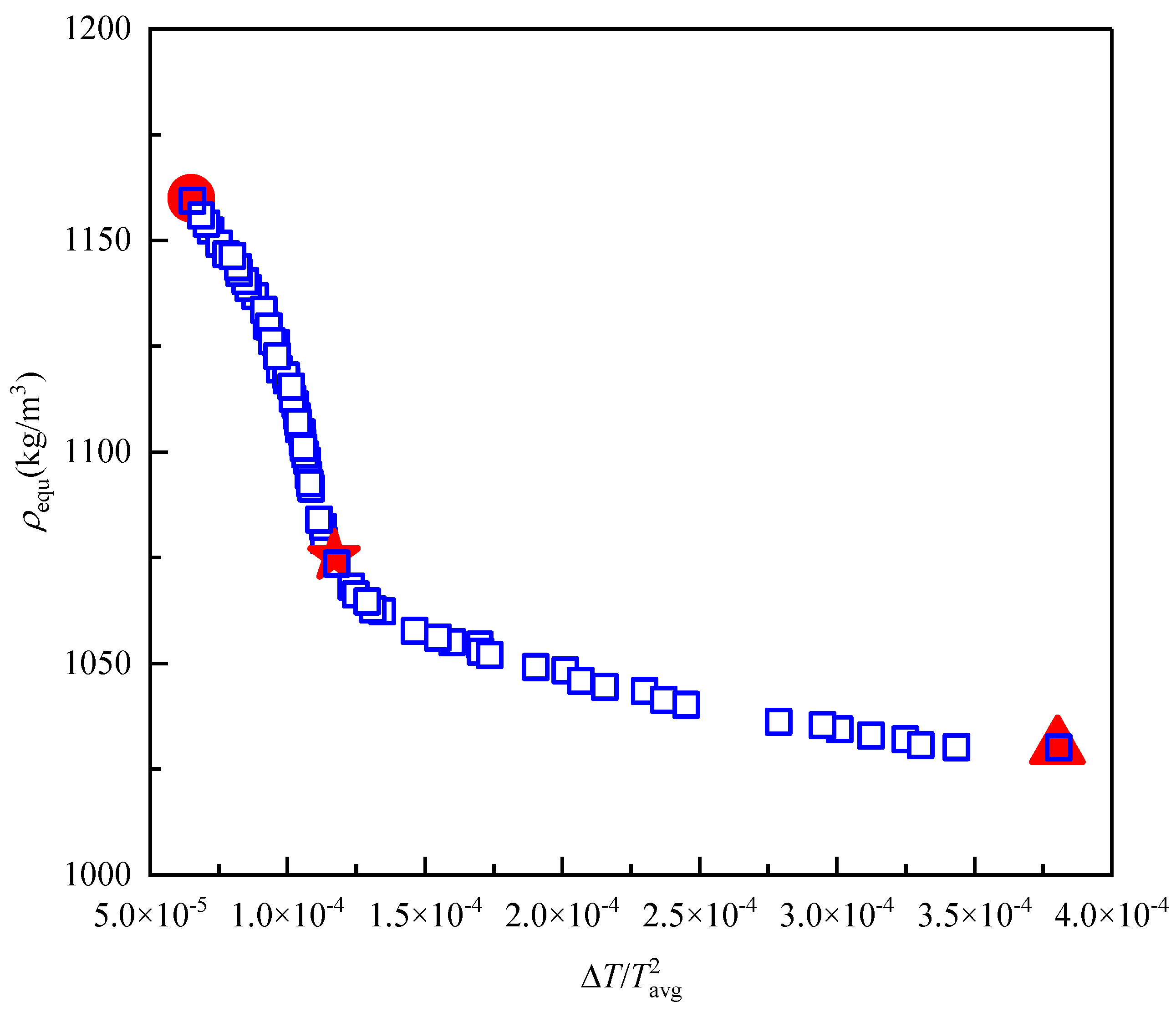


| # | Metal | Thermal Conductivity (W/(m·K)) | Density (kg/m³) |
|---|---|---|---|
| 1 | Au | 315 | 19,320 |
| 2 | Ag | 429 | 10,490 |
| 3 | Cu | 398 | 8960 |
| 4 | Al | 237 | 2700 |
| Variables | Lower Limit | Upper Limit | Variables | Lower Limit | Upper Limit |
|---|---|---|---|---|---|
| d (mm) | 0.1 | 0.2 | w1 (%) | 0 | 20 |
| l1 (mm) | 2 | 4 | w2 (%) | 0 | 20 |
| l2 (mm) | 5 | 10 | k (W/(m·K)) | 200 | 500 |
| h (mm) | 2 | 4 | ρ (kg/m3) | 2000 | 20,000 |
| t (mm) | 0.001 | 0.01 |
| # | Decision Variable | Objective Function Value | ||||||||
|---|---|---|---|---|---|---|---|---|---|---|
| d (mm) | l1 (mm) | l2 (mm) | h (mm) | t (mm) | w1 (%) | w2 (%) | Metal Number | ΔT/T2avg | ρequ (kg/m3) | |
| 1 | 0.101 | 2.001 | 9.552 | 2.001 | 0.009 | 0.006 | 19.534 | 1 | 6.74 × 10−5 | 1.16 × 103 |
| 2 | 0.101 | 2.002 | 7.655 | 2.002 | 0.003 | 0.011 | 0.272 | 4 | 3.25 × 10−4 | 1.03 × 103 |
| 3 | 0.100 | 2.000 | 5.036 | 2.000 | 0.001 | 0.000 | 0.009 | 4 | 3.80 × 10−4 | 1.03 × 103 |
| 4 | 0.101 | 2.001 | 5.021 | 2.001 | 0.008 | 0.006 | 9.643 | 4 | 1.09 × 10−4 | 1.09 × 103 |
| 5 | 0.100 | 2.000 | 5.009 | 2.001 | 0.009 | 0.003 | 11.873 | 4 | 1.04 × 10−4 | 1.11 × 103 |
| 6 | 0.103 | 2.001 | 5.047 | 2.001 | 0.001 | 0.006 | 14.588 | 1 | 9.63 × 10−5 | 1.12 × 103 |
| 7 | 0.101 | 2.001 | 6.162 | 2.002 | 0.006 | 0.006 | 3.795 | 4 | 1.70 × 10−4 | 1.05 × 103 |
| 8 | 0.100 | 2.001 | 5.016 | 2.001 | 0.009 | 0.003 | 7.682 | 4 | 1.13 × 10−4 | 1.08 × 103 |
| 9 | 0.101 | 2.001 | 5.023 | 2.001 | 0.007 | 0.003 | 8.205 | 4 | 1.13 × 10−4 | 1.08 × 103 |
| 10 | 0.101 | 2.001 | 5.066 | 2.001 | 0.009 | 0.006 | 7.098 | 4 | 1.17 × 10−4 | 1.08 × 103 |
| … | … | … | ||||||||
| 47 | 0.101 | 2.000 | 9.428 | 2.000 | 0.010 | 0.003 | 19.875 | 1 | 6.50 × 10−5 | 1.16 × 103 |
| … | … | … | ||||||||
| 70 | 0.103 | 2.001 | 5.047 | 2.001 | 0.001 | 0.006 | 14.590 | 1 | 9.63 × 10−5 | 1.12 × 103 |
| Variables | Optimal Model | Model #47 | Model #3 | Original Model |
|---|---|---|---|---|
| d (mm) | 0.101 | 0.101 | 0.100 | 0.15 |
| l1 (mm) | 2.001 | 2.000 | 2.000 | 3.000 |
| l2 (mm) | 5.066 | 9.428 | 5.036 | 8.000 |
| h (mm) | 2.001 | 2.000 | 2.000 | 3.00 |
| t (mm) | 0.009 | 0.010 | 0.001 | 0.005 |
| w1 (%) | 0.006 | 0.003 | 0.000 | PDMS |
| w2 (%) | 7.098 | 19.875 | 0.009 | PDMS |
| Wire Metal | Al | Cu | Al | Cu |
| ΔT | 1.188 | 0.440 | 3.424 | 36.280 |
| Tavg | 96.722 | 76.489 | 97.205 | 58.841 |
| ΔT/T2avg | 1.27 × 10−4 | 7.52 × 10−5 | 3.62 × 10−4 | 1.05 × 10−2 |
| ρequ (kg/m3) | 1.08 × 103 | 1.16 × 103 | 1.03 × 103 | 1.03 × 103 |
Disclaimer/Publisher’s Note: The statements, opinions and data contained in all publications are solely those of the individual author(s) and contributor(s) and not of MDPI and/or the editor(s). MDPI and/or the editor(s) disclaim responsibility for any injury to people or property resulting from any ideas, methods, instructions or products referred to in the content. |
© 2024 by the authors. Licensee MDPI, Basel, Switzerland. This article is an open access article distributed under the terms and conditions of the Creative Commons Attribution (CC BY) license (https://creativecommons.org/licenses/by/4.0/).
Share and Cite
Deng, Z.; Yu, Q.; Liu, J.; Wang, Y.; Yan, S.; Huai, N.; Zhang, J.; Gao, H. An Optimal Design Method for Lightweight Heating Film of Anisotropic Heat Conduction Substrate Based on Surrogate Model. Micromachines 2024, 15, 970. https://doi.org/10.3390/mi15080970
Deng Z, Yu Q, Liu J, Wang Y, Yan S, Huai N, Zhang J, Gao H. An Optimal Design Method for Lightweight Heating Film of Anisotropic Heat Conduction Substrate Based on Surrogate Model. Micromachines. 2024; 15(8):970. https://doi.org/10.3390/mi15080970
Chicago/Turabian StyleDeng, Zheng, Qingkui Yu, Jingyu Liu, Yanan Wang, Shoubing Yan, Nana Huai, Jingze Zhang, and Huaxing Gao. 2024. "An Optimal Design Method for Lightweight Heating Film of Anisotropic Heat Conduction Substrate Based on Surrogate Model" Micromachines 15, no. 8: 970. https://doi.org/10.3390/mi15080970





